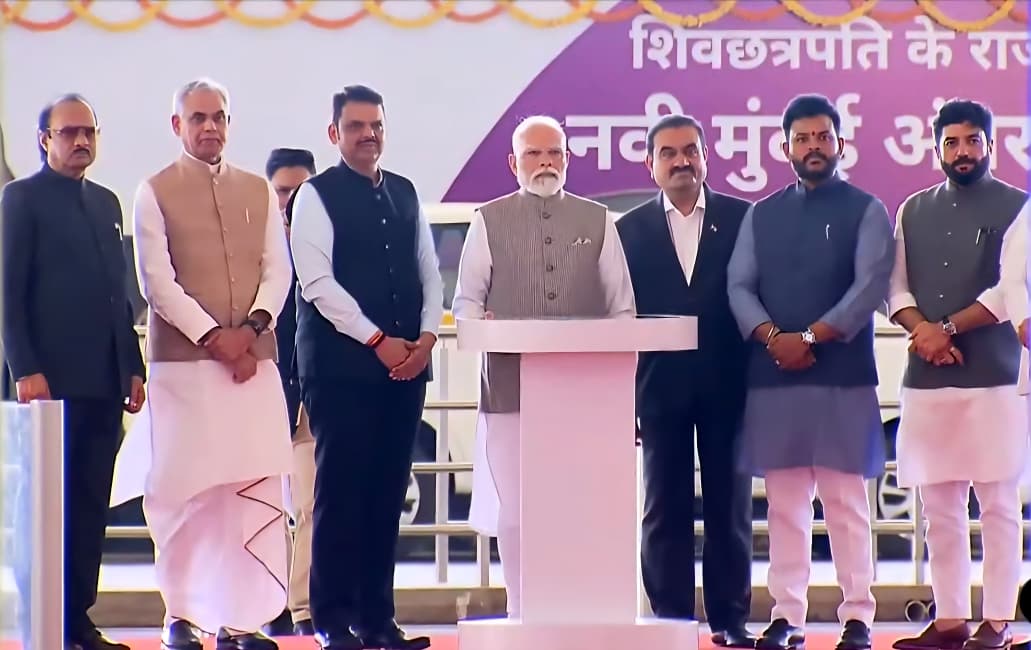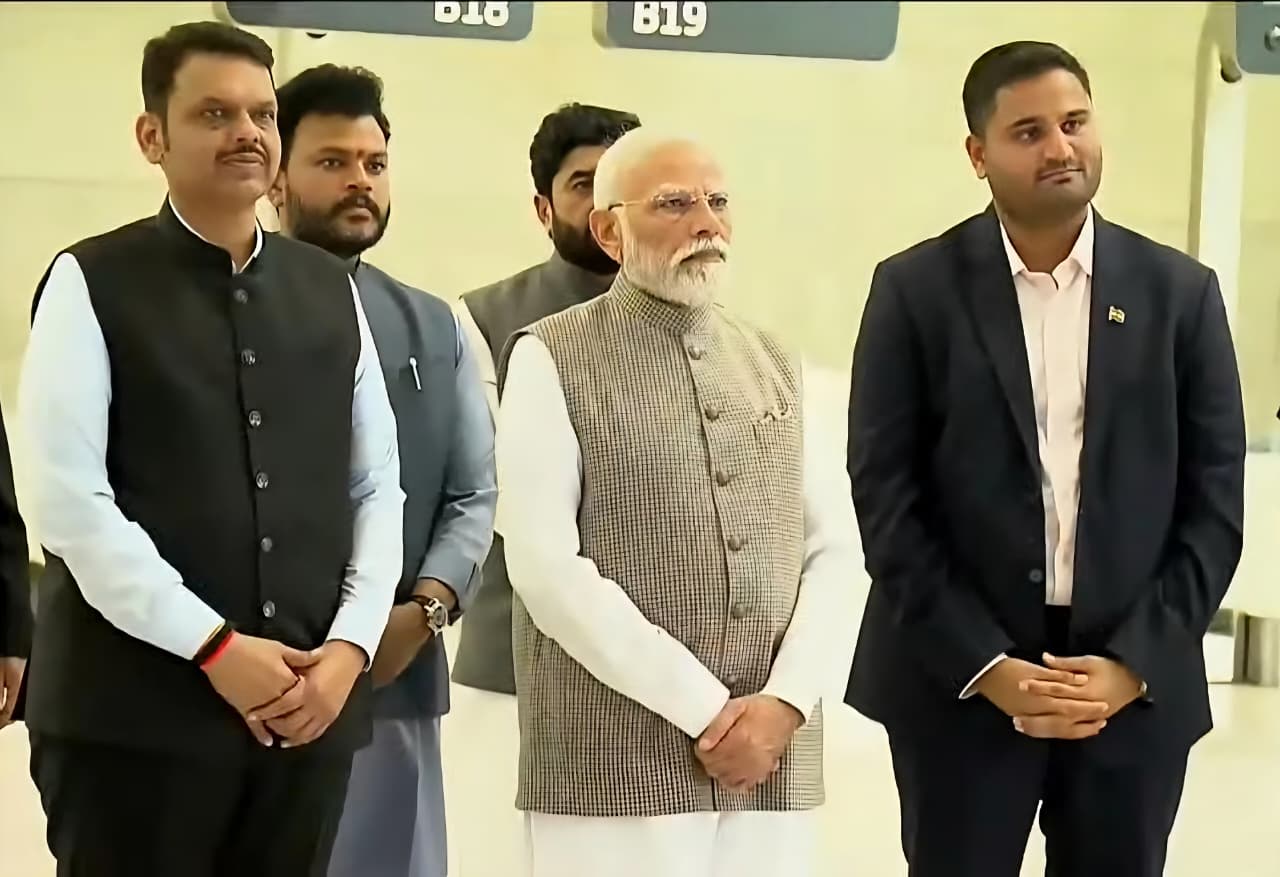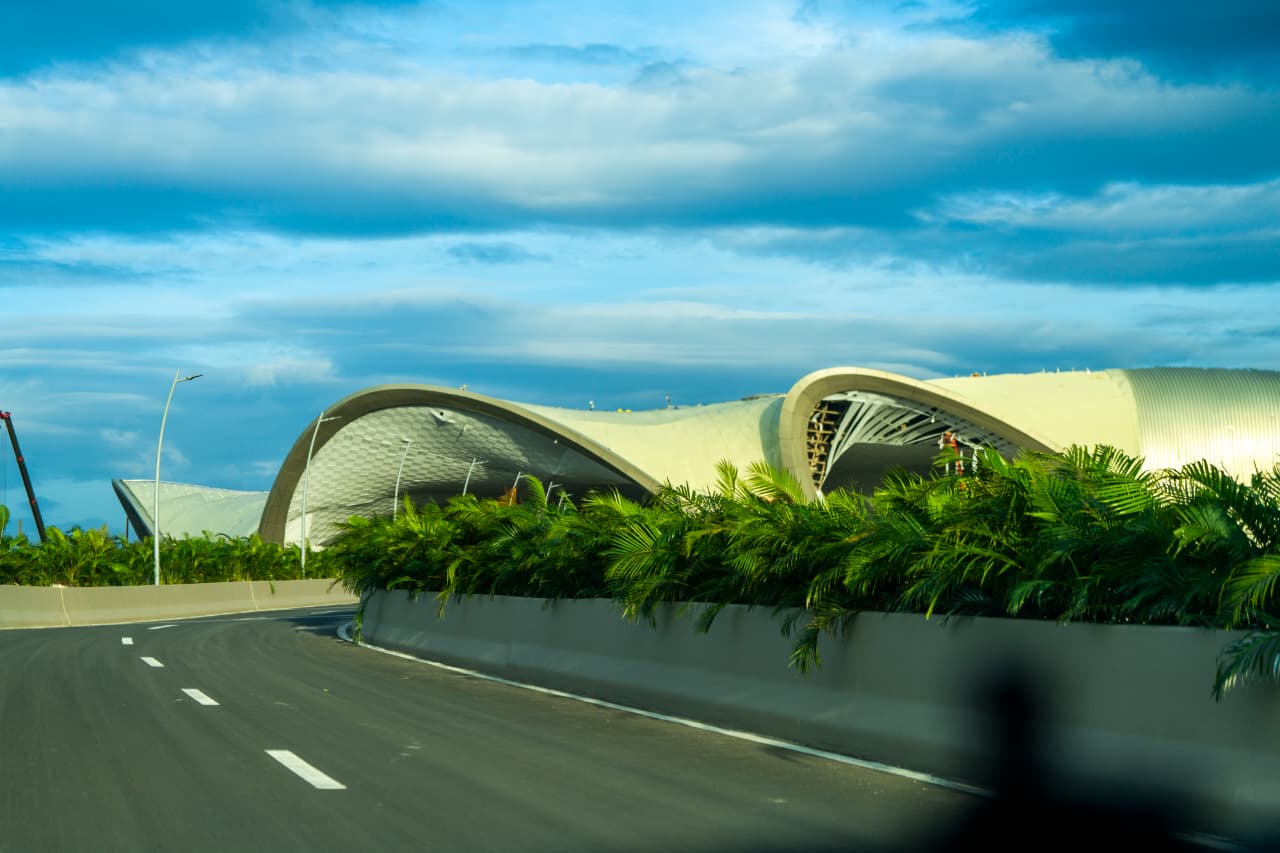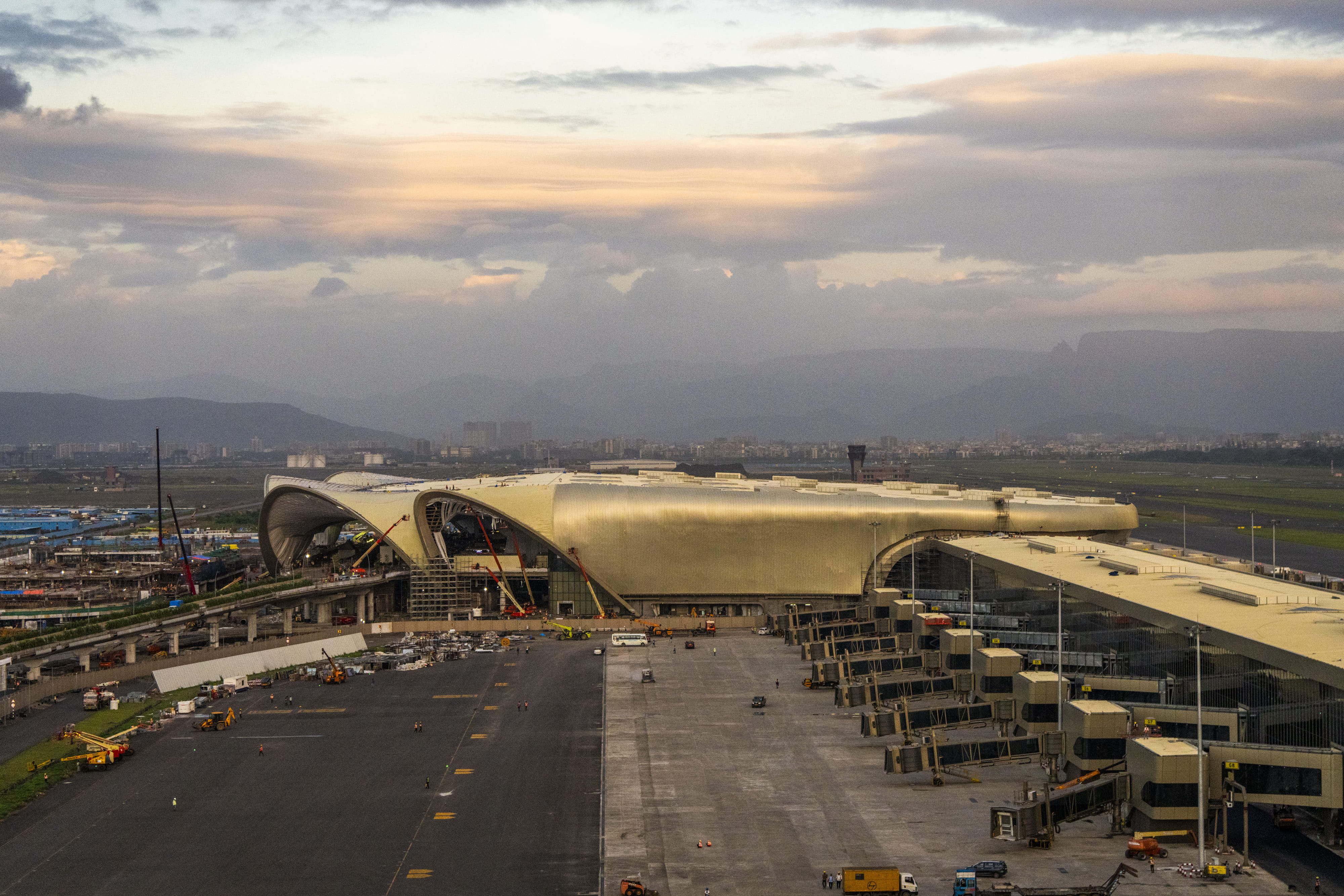Editor’s Synopsis
- The new airport will play a major role in establishing the region as Asia's largest connectivity hub – Prime
Minister.
- NMIA, developed by AAHL and CIDCO, marks a landmark milestone in India’s aviation and infrastructure
journey.
- Designed by Zaha Hadid Architects, NMIA will complement CSMIA, starting with 20 MPPA and scaling up to 90
MPPA.
- Inspired by the Lotus, the airport combines cultural identity, modern design, sustainability and robust
cargo infrastructure to strengthen India’s growing economy.
Navi Mumbai, 08 October 2025: Prime Minister of India Shri Narendra Modi today inaugurated the Navi
Mumbai International Airport (NMIA), one of India’s most ambitious infrastructure projects and a defining milestone
in the nation’s aviation journey. Speaking on the occasion, the Prime Minister said that Mumbai's long wait was over
as the city had now received its second international airport. He added that the Navi Mumbai International Airport
would play a major role in establishing the region as Asia's biggest connectivity hub.
“The Navi Mumbai International Airport is a project that exemplifies the vision of a developed India,”
said the Prime Minister after inaugurating the airport. “It is built on the land of
Chhatrapati Shivaji Maharaj, and its design, resembling a lotus flower, makes it a living symbol of
culture and prosperity. This new airport will connect Maharashtra's farmers directly with the
international supply chain, including supermarkets in Europe and the Middle East. This means that the
farmers' freshest produce — fruits, flowers, vegetables and the products of our fisherfolk — will be
able to reach the global market rapidly. For the small and micro-scale industries in the area, this
infrastructure will reduce logistical costs. It is set to attract increased investment, fostering the
creation of new industries and ventures. I extend my heartiest congratulations to all the people of
Maharashtra and Mumbai on the establishment of this airport.”
Ahead of his speech, the Prime Minister toured the airport and reviewed its world-class facilities,
accompanied by Maharashtra Governor Shri Acharya Devvrat, Maharashtra Chief Minister Shri Devendra
Fadnavis, Union Minister for Civil Aviation Shri Ram Mohan Naidu Kinjarapu, Deputy Chief Ministers of
Maharashtra Shri Ajit Pawar and Shri Eknath Shinde, Union Minister of State for Civil Aviation Shri
Murlidhar Mohol and Adani Airports Director Shri Jeet Adani. The Prime Minister viewed the airport
master plan and was also shown the various tech aspects of the terminal.
NMIA has been developed as a landmark public-private partnership (PPP) between Mumbai International
Airport Limited (MIAL), a subsidiary of Adani Airport Holdings Limited (AAHL), and the City and
Industrial Development Corporation (CIDCO). The project represents a major stride in India’s
infrastructure-building vision, reflecting the Government’s agenda of Viksit Bharat 2047.
“In an era where India ascends among the world’s largest economies, we have built more than an airport –
we have architected Bharat as a gateway and as one of the world’s most indispensable crossroads,” said
Shri Gautam Adani, Chairman of the Adani Group. “This is infrastructure that does not
just serve today’s demand, it creates tomorrow’s exponential possibilities. For generations to come,
every flight through these terminals will carry not just passengers, but the pulse of a defining
superpower and the dreams, ambitions and achievements of a nation reclaiming its place at the centre of
global progress.”
Envisioned as part of a dual-airport system for the Mumbai Metropolitan Region (MMR), NMIA will
complement Chhatrapati Shivaji Maharaj International Airport (CSMIA). With an initial capacity of 20
million passengers per annum (MPPA), the airport will eventually expand to manage 90 MPPA, making it one
of the largest passenger-handling airports in India.
“NMIA is a landmark in India’s aviation journey, uniting cutting-edge technology, sustainability and a
passenger-first experience,” said Shri Jeet Adani, Director, Adani Airport Holdings
Ltd. “By complementing CSMIA, it reinforces Mumbai’s role as a global aviation hub and sets
a blueprint for future-ready airports nationwide.”
Designed as a multimodal hub, NMIA will be seamlessly connected to the Mumbai Trans Harbour Link, Navi
Mumbai and Mumbai Metro, suburban rail networks and planned waterways. This integration will reduce
travel times, enhance regional connectivity and strengthen cargo and passenger movement across the vast
hinterland of western India.
Inspired by the Lotus, India’s national flower, NMIA’s architecture blends cultural heritage with
world-class design and sustainability features, creating an airport that is both rooted in Indian
identity and aligned with future aspirations.
In its first two phases, NMIA will operate with a single runway and terminal capable of handling 20 MPPA.
Over time, the airport will scale to four runways and multiple terminals, with a dedicated cargo terminal and
state-of-the-art facilities for perishables and express cargo, boosting India’s trade and logistics ecosystem.
The inauguration of NMIA underscores India’s determination to create future-ready, world-class
infrastructure that supports economic growth, global competitiveness, and the aspirations of citizens. As the nation
advances toward Viksit Bharat 2047, NMIA stands as a symbol of modern engineering, collaborative development, and
India’s rising stature in the global aviation landscape.
About Navi Mumbai International Airport Limited
Navi Mumbai International Airport Private Limited (NMIAL) is a special purpose vehicle established for the
development, construction, operation, and maintenance of the greenfield international airport project at Navi
Mumbai, Maharashtra. NMIAL is a Public Private Partnership (PPP) between Mumbai International Airport Limited
(MIAL), a subsidiary of Adani Airports Holdings Limited (AAHL), which holds the majority stake of 74 percent, while
the City and Industrial Development Corporation of Maharashtra Limited (CIDCO), a Government of Maharashtra
undertaking, holds the remaining 26 percent.
Navi Mumbai International Airport (NMIA) (IATA: NMI; ICAO: VANM), is set to become one of the busiest and most
significant aviation hubs in India. Located in Navi Mumbai, Maharashtra, NMIA is strategically positioned to cater
to the burgeoning air traffic demands of the Mumbai Metropolitan Region and Western India. Spanning over 1,160
hectares (2,866 acres), on completion, NMIA is designed to handle 90 million passenger per annum (MPPA). The airport
will feature two parallel runways, state-of-the-art terminal buildings, and advanced cargo facilities, ensuring
seamless passenger experience and efficient cargo handling. NMIA is set to be a greenfield airport with sustainable
and eco-friendly infrastructure, incorporating renewable energy sources and green building practices. The fluid and
futuristic design is influenced by the Lotus, India’s national flower.
In the initial phase, NMIA will have the capacity to manage 20 MPPA and 0.5 million metric tonnes of cargo annually.
NMIA is committed to setting new benchmarks in operational efficiency, sustainability, and passenger satisfaction.
With its modern infrastructure and strategic location, NMIA is poised to become a prominent gateway to India and a
significant player in the global aviation industry.
Annexure
Twin Airport
Mumbai’s New Gateway Across the Harbour presents Navi Mumbai International Airport (NMIA) as a landmark development
that will reshape the region’s travel and growth landscape. Rising over Ulwe near Panvel, the airport spans 1,160
hectares and is designed to accommodate up to 90 million passengers annually in its full build-out, working in
synergy in a twin airport System and easing pressure on Mumbai’s Chhatrapati Shivaji Maharaj International Airport
(CSMIA) while extending connectivity to Thane, Pune, Raigad and the Konkan belt. With the Atal Setu offering a
20-minute link from South Mumbai, strengthened by the Sion–Panvel Highway, NMIA will be at the heart of an
integrated transport network. Its creation has involved vast engineering efforts, from tunnelling hills to
relocating villages. Already fuelling real estate, logistics and business expansion across Navi Mumbai, NMIA signals
a shift in Mumbai’s economic gravity while offering Maharashtra a chance to showcase world-class infrastructure and
balanced urban growth.
Airport Offerings
Set for inauguration soon, NMIA marks a transformative chapter for Mumbai’s aviation landscape. NMIA introduces a
twin-airport model alongside CSMIA, easing congestion and expanding connectivity through road, metro, suburban rail,
and water links. Launching with Terminal 1, designed to handle 20 million passengers annually, blending cultural
motifs with sustainable architecture and offering advanced check-in, security and baggage systems. Upon completion,
the airport will feature four terminals with a cumulative 90 million annual passenger capacity and cargo facilities
capable of 3.2 million tonnes annually will strengthen Mumbai’s global standing, creating an aviation ecosystem
rivalling Dubai, London, and New York.
A New Landmark
Navi Mumbai International Airport (NMIA), designed by Zaha Hadid Architects, draws inspiration from the lotus flower,
a timeless symbol in Indian culture. NMIA's design showcases the terminal roof suggesting petals and the central
atrium resembles a lotus pond. The airport's architecture aims to create a calming and intuitive environment for
travellers while embedding cultural meaning into a 21st-century modern, digital-first aviation hub. Like the lotus
rising from muddy waters, NMIA symbolises resilience and renewal for Mumbai and India. This cultural symbolism
combined with practical, sustainable features like passive cooling and natural light makes NMIA a landmark that
redefines how India presents itself to the world.
Maharashtra's New Economic Engine
NMIA is set to transform Maharashtra's economy and infrastructure upon its inauguration. The airport will ease the
burden on CSMIA, which operates near capacity. NMIA is expected to handle 90 million passengers annually when fully
operational, nearly double the existing capacity of Mumbai. Experts predict NMIA will attract billions in foreign
and private investments and boost Maharashtra's GDP by 0.5%. This will also spur real estate growth, with property
prices appreciating by as much as 30% in key areas. The airport is also designed with sustainability in mind,
incorporating features like solar power and rainwater harvesting.
NMIA's Two-Decade Journey
Navi Mumbai International Airport (NMIA) is the result of nearly two decades of effort, beginning with the Union
Cabinet's approval in 2007 to relieve congestion at Mumbai's existing airport. The project navigated significant
hurdles between 2011 and 2017, including complex resettlement, environmental clearances, and engineering challenges.
In 2021, the Adani Group took over the Rs. 16,700 crore PPP, ensuring a single operator for Mumbai's twin-airport
system. Construction accelerated following the land handover in 2022, with Zaha Hadid's lotus-inspired terminal
design unveiled in 2023. After test landings in 2024. NMIA will initially handle 20 million passengers annually,
positioning Mumbai alongside global twin-airport cities.
New Frontiers in Air Freight
NMIA is designed as a logistics hub, with cargo as a core focus, capable of handling 0.5 million tonnes annually in
its first phase. The airport is introducing several firsts in Indian air cargo, including a fully automated terminal
with AI monitoring that can cut turnaround time by 40%. It also features a Pharma Excellence Centre with
GDP-compliant cold zones and a dedicated perishable cargo village. Crucially, NMIA’s proximity (20 km) to the
Jawaharlal Nehru Port Trust (JNPT) creates an integrated logistics cluster for sea-air transshipment. This
dual-engine strategy is expected to support key sectors like agriculture and pharmaceuticals.
Retail Offerings
NMIA is shifting to a "passenger to product strategy" for non-aeronautical revenue, which can account for up to 40%
of revenues at global hubs. The airport is designed to be a destination, not just a gateway. NMIA plans 110 retail
and Food & Beverage (F&B) outlets, including 1,800 sq. m. of duty-free shops in both arrivals and departures. The
strategy includes creating experiential zones to increase passenger engagement and dwell time, and F&B offerings
featuring local Mumbai concepts. The landside area will offer entertainment and dining zones accessible to
non-passengers, expanding the customer base. With over 67 general aviation stands planned, NMIA is also targeting
premium travellers. The aim is to bridge the gap with global non-aero revenue benchmarks.
NMIA: Lotus in Steel and Glass
NMIA, designed by Zaha Hadid Architects, is an engineering and cultural landmark rooted in the lotus flower metaphor.
The structure features a dual column system: 12 sculptural feature columns guide passenger movement and allow
natural light to cascade through, while 17 robust mega columns support the immense lotus roof. This innovative
system creates vast, open spaces, with the roof appearing to float above the terminal. The complex, curving design
of the petals required bespoke moulds and millimetre-level precision during construction. The roof is also
performance-driven, managing rainwater and reducing wind resistance, successfully merging cultural expression with
practical engineering for passenger experience.

















